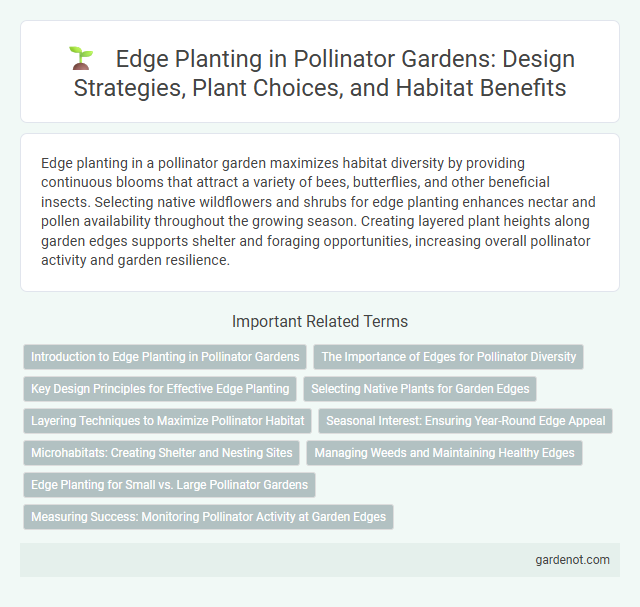Edge planting in a pollinator garden maximizes habitat diversity by providing continuous blooms that attract a variety of bees, butterflies, and other beneficial insects. Selecting native wildflowers and shrubs for edge planting enhances nectar and pollen availability throughout the growing season. Creating layered plant heights along garden edges supports shelter and foraging opportunities, increasing overall pollinator activity and garden resilience.
Introduction to Edge Planting in Pollinator Gardens
Edge planting in pollinator gardens maximizes habitat diversity by incorporating flowering plants along garden perimeters, attracting a range of beneficial insects like bees, butterflies, and hoverflies. Strategically placing native wildflowers and flowering shrubs at garden edges enhances nectar and pollen accessibility, promoting pollinator foraging efficiency and biodiversity. This planting technique strengthens ecological corridors, supporting pollinator movement and improving overall garden ecosystem health.
The Importance of Edges for Pollinator Diversity
Edge planting in pollinator gardens creates crucial transitional zones that support a higher diversity of pollinators by offering varied microhabitats and resources. These edge habitats enhance foraging opportunities and shelter for bees, butterflies, and other pollinating insects, fostering ecological niches that boost overall biodiversity. Incorporating native flowering plants along garden edges maximizes nectar and pollen availability, promoting healthy pollinator populations essential for ecosystem resilience.
Key Design Principles for Effective Edge Planting
Edge planting in pollinator gardens maximizes habitat diversity by incorporating native wildflowers, grasses, and shrubs that provide continuous bloom cycles and shelter for pollinators. Strategic layering of plant heights supports various pollinator species while enhancing microclimate conditions and soil stability along garden boundaries. Selecting plants with staggered flowering times and diverse nectar sources increases pollinator visitation rates, promoting ecosystem resilience and biodiversity.
Selecting Native Plants for Garden Edges
Selecting native plants for garden edges supports local pollinators by providing essential nectar and pollen sources adapted to the regional climate and soil conditions. Native species such as purple coneflower, black-eyed Susan, and bee balm create a vibrant habitat that encourages pollinator diversity and enhances overall ecosystem health. Integrating these plants into edge planting strategies ensures sustained food availability and nesting sites for bees, butterflies, and other beneficial insects throughout the growing season.
Layering Techniques to Maximize Pollinator Habitat
Edge planting in pollinator gardens utilizes layering techniques by arranging vegetation in tiered structures, combining ground covers, mid-height perennials, and taller shrubs. This stratified approach increases floral diversity and bloom continuity, providing essential nectar sources and nesting sites for bees, butterflies, and other pollinators. Strategic layering enhances microhabitats and optimizes resource availability, supporting a robust and resilient pollinator ecosystem.
Seasonal Interest: Ensuring Year-Round Edge Appeal
Edge planting in a pollinator garden maximizes seasonal interest by incorporating a diverse selection of native perennials and annuals that bloom sequentially from early spring to late fall. Strategically selecting plants such as early-blooming crocus, mid-season coneflowers, and late-blooming goldenrod guarantees continuous nectar and pollen sources for pollinators throughout the year. This approach enhances the garden's visual appeal while providing essential habitat and foraging opportunities for bees, butterflies, and other pollinating insects across all seasons.
Microhabitats: Creating Shelter and Nesting Sites
Edge planting in a pollinator garden enhances biodiversity by establishing microhabitats that provide essential shelter and nesting sites for pollinators such as bees, butterflies, and hummingbirds. Strategically using native shrubs, grasses, and flowering perennials at garden borders supports diverse species by offering protection from predators and harsh weather conditions. This approach boosts pollinator populations, promoting a resilient and productive ecosystem while encouraging natural pest control and pollination services.
Managing Weeds and Maintaining Healthy Edges
Edge planting in pollinator gardens enhances habitat diversity by creating transitional zones that support beneficial insects while suppressing invasive weeds. Managing weeds through targeted mulching and selective hand weeding prevents competition, promoting vigorous growth of native flowering plants essential for pollinators. Maintaining healthy edges involves regular monitoring and soil enrichment to sustain plant health, ensuring optimal nectar and pollen availability year-round.
Edge Planting for Small vs. Large Pollinator Gardens
Edge planting in small pollinator gardens maximizes limited space by concentrating native flowering plants along borders, enhancing habitat connectivity and nectar availability. In large pollinator gardens, edge planting serves as a strategic buffer zone to support diverse pollinator species by integrating a variety of plant heights, bloom times, and structural complexity. Tailoring edge planting designs to garden size improves pollinator foraging efficiency, biodiversity, and overall ecosystem resilience.
Measuring Success: Monitoring Pollinator Activity at Garden Edges
Measuring pollinator activity at garden edges involves systematic monitoring of insect visitation rates, species diversity, and foraging behavior to assess the effectiveness of edge planting strategies. Utilizing tools such as timed flower counts, photographic surveys, and insect traps provides quantitative data for evaluating habitat quality and pollination success. Consistent monitoring at the garden periphery enhances understanding of how edge habitats contribute to supporting pollinator populations and informs adaptive management practices.
Edge planting Infographic

 gardenot.com
gardenot.com